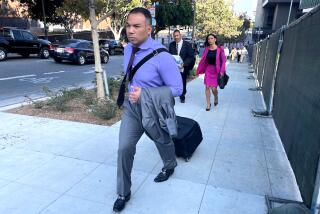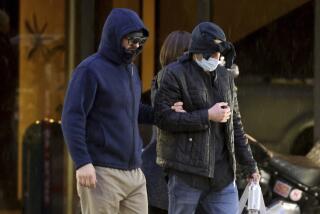Cleveland bomb case: Role of FBI informant will be key
As the case of five men charged with plotting to blow up a Cleveland-area bridge goes forward, one of the key questions will revolve around the role of the FBI’s confidential informant in the case. That informant was at the center of discussions and, according to at least one defense lawyer, may have been too active.
The five men are scheduled to appear in federal court Monday for a hearing on charges including conspiracy and trying to bomb property used in interstate commerce. The government alleges that the group was involved in an anarchist plot to make a violent political statement against the wealthy and powerful in time for May Day, which honors workers’ struggles around the world. If convicted, each faces more than 20 years in prison.
All are expected to plead not guilty. The bigger question will be their defense, and one lawyer has already called into question the role of the person expected to be the key witness, a confidential informant. Such a defense would be similar to that of other terrorism-type cases involving a sting or the use of an informant.
Defense lawyer John Pyle, who represents one of the defendants, Brandon Baxter, told the Associated Press that the informant’s role needed to be examined.
“We need to … put the case under a microscope,” Pyle said. “But just on the basis on the filing in the court, there’s some indicators that this informant was playing a really active role.”
The informant, identified in court papers as “Confidential Human Source,” has been working for the FBI since July 20, and received approximately $5,750 for services and $550 for expenses.
The payments stopped when the informant began probation on a charge of passing bad checks. According to the affidavit filed with the criminal complaint, the source’s criminal record includes a conviction for possessing cocaine in 1990, a conviction for robbery in 1991 and four convictions for passing bad checks between 1991 and 2011.
Perhaps more important is the source’s role. According to the affidavit, the FBI directed the source to attend a demonstration on Oct. 21, because law enforcement had “an initial report of potential criminal activity and threats involving anarchists who would be attending” a protest in Cleveland. At the demonstration, the source made the first contact with some of the suspects.
In later meetings, the source recorded numerous conversations and was present as the plans to blow up the bridge were allegedly firmed up. Eventually, the group’s members reportedly purchased what they thought were explosives from an undercover FBI employee, along with the purported codes and cellphone equipment needed to bring down a bridge. The reported target was a span crossing the Cuyahoga Valley National Park south of downtown Cleveland.
Authorities said the group tried to detonate the explosives but nothing happened. The defendants were arrested in a car near the bridge Monday night.
It is not unusual to use informants or even stings in law enforcement. Those who’ve spent even a small amount of time watching the myriad number of crime and law shows on television know that there’s usually a jailhouse snitch ready to make a deal by incriminating a defendant.
In real life, a number of mob trials have depended on a gangster who turned on former colleagues. In the area of fighting public corruption, probably the most famous case was Abscam in the late 1970s. In that case, an FBI employee masqueraded as a Middle East sheik and was videotaped offering money in exchange for political favors. Eventually, a U.S. senator and five congressmen were convicted of corruption.
The government’s use of informants and stings has become very visible -- and more controversial -- since the Sept. 11 attacks. Undercover informants played major roles in alleged plots to bomb New York synagogues, set off a bomb near Chicago’s Wrigley Field, attack a federal courthouse in Illinois and blow up a building in Dallas.
In all of the cases, the federal government said it used the resources that were available. But in at least one case, the tactics were not greeted with enthusiasm by the judge.
In September in New York, District Judge Colleen McMahon handed down a mandatory 25-year prison sentence in a plot to bomb synagogues and shoot down military planes with missiles. But she made it clear that she was unhappy with how the government had run a sting.
That operation began in 2008 after an FBI informant was assigned to infiltrate a mosque in Newburgh, N.Y. The informant pretended to be a representative of a Pakistani terrorist organization eager to finance jihad against the United States; he was also a key player in the plot. The informant later testified against the group, each of whom received the mandatory 25-year sentence.
“The essence of what occurred here was that a government, understandably zealous to protect its citizens, created acts of terrorism out of the fantasies and the bravado and the bigotry of one man in particular and four men generally and then made these fantasies come true,” McMahon noted in court, as reported by the Associated Press. “The government made them terrorists.... I am not proud of my government for what it did in this case.”
ALSO:
N.J. Gov. Chris Christie writes excuse note for 11-year-old
Ownership of big cats should be restricted, U.S. lawmakers say
Adis Medunjanin convicted in terror plot to bomb New York subways
michael.muskal@latimes.com
More to Read
Start your day right
Sign up for Essential California for news, features and recommendations from the L.A. Times and beyond in your inbox six days a week.
You may occasionally receive promotional content from the Los Angeles Times.







